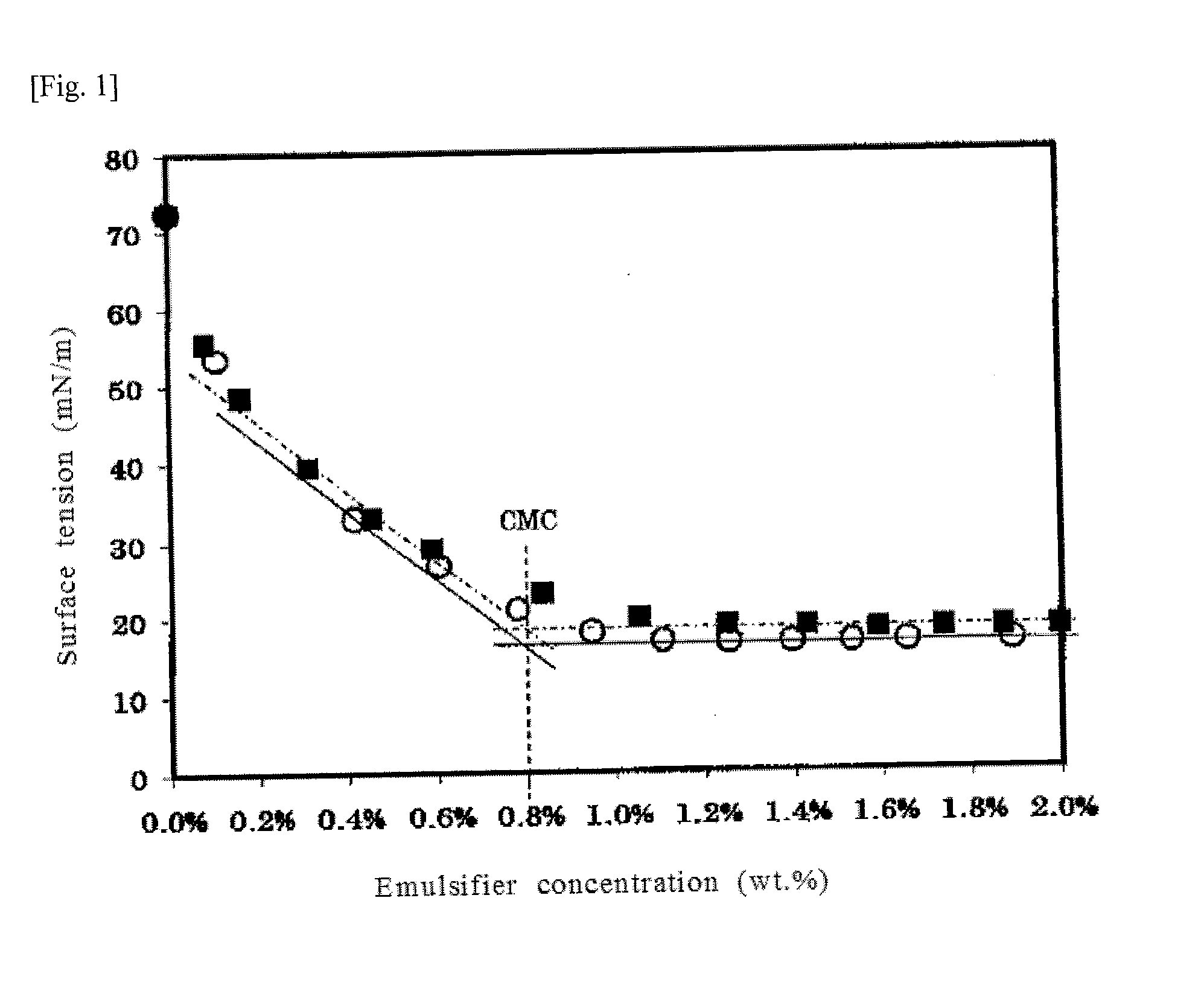Emulsion and mold-releasing agent using the same
a technology of emulsion and mold, which is applied in the direction of foundry molds, other chemical processes, foundry patterns, etc., can solve the problems of many treatment processes, insufficient durability, and uneven coating properties of molded products, and achieve excellent emulsification stability, excellent emulsification performance, and low bioaccumulation potential
- Summary
- Abstract
- Description
- Claims
- Application Information
AI Technical Summary
Benefits of technology
Problems solved by technology
Method used
Image
Examples
example 1
[0054](1) In a 200-ml reactor equipped with a stirrer and a dropping funnel, 50 g of water heated to 40° C. was charged while keeping the water warm, and 5 g (11.7 mmol) of 2-(perfluorohexyl)ethyl phosphonic acid (CHEMINOX FHP-2-OH, produced by Unimatec Co., Ltd.) was added thereto. Then, 20.5 g (16.9 mmol) of an aqueous ammonia solution with a concentration of 1.4 wt. % was added, and stirring was continued for one hour to perform neutralization reaction. As a result, an aqueous solution of 2-(perfluorohexyl)ethyl phosphonic acid ammonium salt having a pH of 8 (active ingredient concentration: 6.9 wt. %) was obtained [emulsifier aqueous solution I].
[0055]The emulsifier aqueous solution I was gradually added with each small amounts to water, and the surface tension of the aqueous solution was measured. As shown by circles (O) in the graph of FIG. 1, the critical micelle concentration [CMC] of the solution was 0.8 wt. %, and the minimum surface tension was 17 mN / m. The surface tensio...
reference example 1
[0060]In Example 1 (1), 5 g of pentadecafluorooctanoic acid ammonium salt (EFTOP EF-204, produced by Jemco Co., Ltd.) was used in place of the of 2-(perfluorohexyl)ethyl phosphonic acid and aqueous ammonia solution, thereby obtaining an aqueous solution of the ammonium salt (active ingredient concentration: 9.1 wt. %) [emulsifier aqueous solution II].
[0061]When the surface tension of the emulsifier aqueous solution II was measured in the same manner, the CMC of the solution was 0.8 wt. %, and the minimum surface tension was 18 mN / m, as shown by black squares (i) in the graph of FIG. 1.
example 2
[0062]In Example 1 (2), the same amount (100 g) of perfluoropolyether oil represented by the same general formula (BARRIERTA J 100 FLUID, produced by NOK Kluber Co., Ltd.; kinetic viscosity (40° C.): 95 mm2 / s) was used (total amount: 500 g), thereby obtaining 486 g (recovery rate: 97%) of perfluoropolyether oil emulsion B. The average particle diameter of the emulsion B was 131 nm, the average particle diameter after one month at room temperature was 136 nm, and the average particle diameter after one month at 40° C. was 140 nm. Thus, it was confirmed that the formed emulsion was stable.
PUM
| Property | Measurement | Unit |
|---|---|---|
| weight | aaaaa | aaaaa |
| emulsion | aaaaa | aaaaa |
| aqueous | aaaaa | aaaaa |
Abstract
Description
Claims
Application Information
 Login to View More
Login to View More - R&D
- Intellectual Property
- Life Sciences
- Materials
- Tech Scout
- Unparalleled Data Quality
- Higher Quality Content
- 60% Fewer Hallucinations
Browse by: Latest US Patents, China's latest patents, Technical Efficacy Thesaurus, Application Domain, Technology Topic, Popular Technical Reports.
© 2025 PatSnap. All rights reserved.Legal|Privacy policy|Modern Slavery Act Transparency Statement|Sitemap|About US| Contact US: help@patsnap.com

